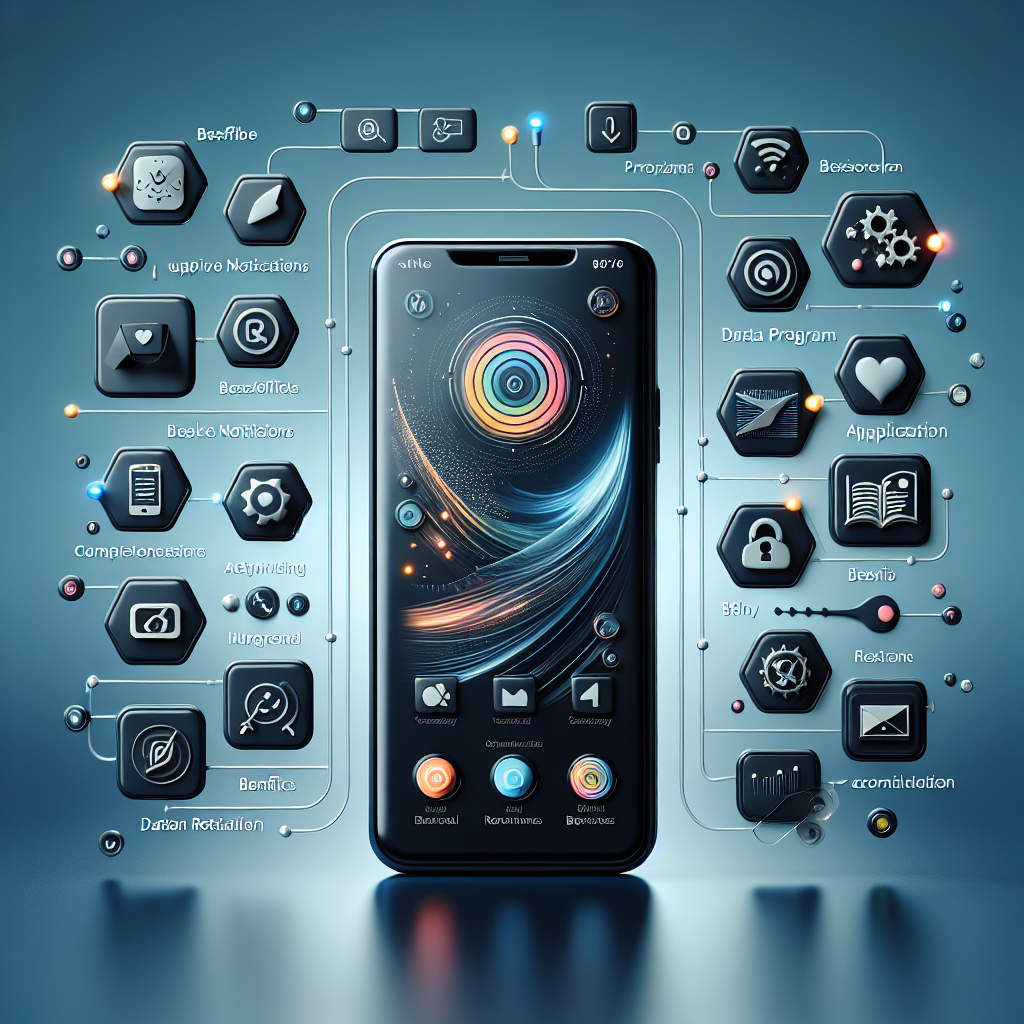In the competitive world of mobile applications, simply acquiring users is not enough; retaining them is equally, if not more, important. *Mobile app retention strategies* are designed to keep users engaged and coming back to your app consistently. High retention rates indicate that your app provides value to its users, which is crucial for long-term success.
Retention strategies encompass various techniques and best practices that aim to enhance user experience, foster loyalty, and encourage continuous usage. From personalized notifications to loyalty programs, these strategies are essential for maintaining a robust user base. Understanding and implementing these tactics can make a significant difference in your app’s performance and overall success.
To get started on crafting an effective retention strategy, it’s important to know your audience, understand their needs, and continuously optimize the user experience. This involves leveraging analytics to gather insights and making informed decisions. Furthermore, an effective onboarding process can significantly impact user retention, as it sets the tone for the user’s journey with your app.
Ready to take your app retention to the next level? Book A Consultation Now! and let our experts guide you through the intricacies of mobile app retention strategies tailored to your specific needs.
Importance of User Retention in Mobile Apps

User retention is a critical metric for the success of any mobile application. It goes beyond merely attracting users; it focuses on keeping them engaged and making them regular users of your app. High user retention rates are indicative of a healthy app that meets the needs and expectations of its users.
One of the main reasons why *user retention* is so important is because acquiring new users is significantly more expensive than retaining existing ones. Studies show that it costs five times as much to attract a new customer than to keep an existing one. Therefore, focusing on retention can be a more cost-effective strategy in the long run.
Additionally, retained users are more likely to become loyal customers and brand advocates. These users tend to generate more revenue over time, either through in-app purchases, subscriptions, or ad interactions. They are also more likely to provide valuable feedback, which can be used to improve the app and further enhance user satisfaction.
Moreover, high user retention rates can boost your app’s visibility and ranking in app stores. App stores often use retention rates as a key factor in their algorithms to determine which apps to feature and promote. Therefore, an app with high retention rates is more likely to appear in top charts and recommendations, attracting even more users.
In summary, focusing on user retention not only helps in cost savings but also contributes to the overall growth and success of your mobile app. By prioritizing user retention, you can foster a loyal user base, generate more revenue, and enhance your app’s visibility in the competitive app market.
Effective Onboarding Process for New Users

An effective onboarding process is crucial for ensuring new users understand the value of your mobile app and how to use it efficiently. A well-designed onboarding experience can significantly boost user retention rates by making a positive first impression and reducing the learning curve.
There are several key elements to consider when designing an *effective onboarding process*. Firstly, it’s essential to keep the onboarding steps concise and focused. Users should be able to start using the app’s core features as quickly as possible without feeling overwhelmed by too much information. Utilize *progressive disclosure* to introduce advanced features gradually as users become more comfortable with the app.
Interactive tutorials and tooltips can be highly effective in guiding users through the initial setup and highlighting important features. These interactive elements can provide hands-on experience, making it easier for users to understand and remember how to use the app. Additionally, incorporating visual aids such as images, animations, and videos can enhance the onboarding experience by making it more engaging and easier to follow.
Personalization is another crucial aspect of an effective onboarding process. Tailoring the onboarding experience to individual users’ needs and preferences can make them feel more valued and understood. For instance, you can ask users a few simple questions at the beginning to customize their experience or offer personalized recommendations based on their preferences.
Moreover, providing a seamless and intuitive signup process is vital. Allow users to sign up using their social media accounts or email addresses to minimize friction and make the process as smooth as possible. Ensure that the signup forms are straightforward and only ask for essential information to avoid deterring users from completing the process.
In conclusion, a well-crafted onboarding process is essential for engaging new users and setting the stage for long-term retention. By focusing on simplicity, interactivity, personalization, and seamless signup, you can create a positive onboarding experience that encourages users to continue using your app.
Personalization and User Engagement Techniques

Personalization and user engagement techniques play a pivotal role in improving mobile app retention rates. By tailoring the app experience to individual users’ preferences and behaviors, you can create a more relevant and enjoyable experience that keeps users coming back.
One of the most effective personalization strategies is leveraging user data to offer *customized content* and recommendations. Analyzing user behavior, such as their past interactions, search history, and in-app activity, allows you to present content and features that resonate with their interests and needs. For example, a music streaming app might recommend playlists based on the user’s listening habits, while an e-commerce app could highlight products similar to those the user has previously viewed or purchased.
Push notifications are another powerful tool for maintaining user engagement. However, they must be used thoughtfully to avoid becoming intrusive. Personalized push notifications, such as reminders about abandoned carts, special offers, or updates on topics of interest, can re-engage users and encourage them to return to the app. Ensure that these notifications are timely and relevant, and provide users with the option to customize their notification preferences.
In-app messaging is also crucial for fostering user engagement. This can include targeted messages that welcome new users, offer tips and tricks, or notify users about new features or updates. By delivering these messages at the right moments, you can guide users through their journey and enhance their overall experience.
Gamification is another technique that can significantly boost user engagement. Incorporating elements such as rewards, badges, leaderboards, and challenges can make the app experience more enjoyable and motivating. For instance, a fitness app might reward users with badges for achieving their workout goals, or a learning app could offer points for completing lessons and quizzes.
Lastly, social features can enhance user engagement by fostering a sense of community. Integrating social sharing options, user-generated content, and community forums allows users to connect with others, share their experiences, and stay engaged with the app. Encouraging users to invite friends and participate in social activities can also drive organic growth and retention.
By implementing these personalization and user engagement techniques, you can create a more compelling and satisfying app experience that keeps users engaged and coming back for more.
Utilizing Push Notifications Strategically

Utilizing push notifications strategically is essential for maintaining high mobile app retention rates. When used correctly, push notifications can effectively re-engage users and encourage them to return to your app. However, it’s crucial to strike the right balance to avoid overwhelming users, which can lead to app uninstalls.
First, it’s important to focus on *personalization*. Generic push notifications are often ignored or even perceived as spam. By leveraging user data, you can tailor notifications to individual preferences and behaviors. For instance, a news app can send notifications about breaking news tailored to the user’s interests, while a shopping app might notify users about sales on their favorite brands.
Timing is another critical aspect of push notification strategy. Sending notifications at the right time can significantly influence their effectiveness. Consider the user’s time zone and daily routine to ensure that notifications arrive when they are most likely to engage. For example, a meal planning app might send recipe suggestions just before meal times, or a fitness app could send workout reminders in the morning or evening based on user preferences.
Frequency is just as important as timing. Bombarding users with too many notifications can lead to frustration and app abandonment. Aim to find a balance that keeps users informed and engaged without being intrusive. Offering users control over their notification preferences, such as the type and frequency of notifications, can also enhance user satisfaction and retention.
Content quality is paramount. Each push notification should provide genuine value to the user. This could be in the form of important updates, personalized recommendations, or exclusive offers. For example, a travel app might send notifications about flight status changes, special discounts, or travel tips relevant to the user’s upcoming trip. High-quality, relevant content increases the likelihood that users will appreciate and act on the notifications.
Lastly, incorporating *actionable elements* into push notifications can drive user engagement. Allow users to take immediate action directly from the notification, such as redeeming a discount, replying to a message, or completing a survey. This not only makes the notification more interactive but also reduces friction and encourages user interaction.
By strategically utilizing push notifications, you can create a more engaging and personalized user experience, ultimately boosting your app’s retention rates and ensuring long-term success.
Gathering and Analyzing User Feedback
Gathering and analyzing user feedback is a cornerstone of effective mobile app retention strategies. By actively listening to your users, you can gain valuable insights into their needs, preferences, and pain points, allowing you to make informed decisions that enhance the overall user experience.
The first step in this process is to establish multiple channels for collecting feedback. These can include in-app surveys, feedback forms, app store reviews, and direct communication through customer support. Each channel offers unique advantages and can capture different aspects of user sentiment. For instance, in-app surveys can provide immediate, contextual feedback, while app store reviews offer a more public perspective on user satisfaction.
Next, it’s important to encourage users to share their feedback. This can be done through timely prompts within the app, offering incentives such as discounts or rewards, and ensuring that the process is as seamless as possible. The more feedback you gather, the better you can understand the diverse needs of your user base.
Once you’ve collected feedback, the real work begins with analyzing the data. Look for recurring themes and patterns that indicate common issues or areas for improvement. Advanced analytics tools can help you segment feedback based on user demographics, behavior, and app usage, providing deeper insights into specific user groups. For example, you might discover that new users are struggling with the onboarding process, while long-term users are requesting more advanced features.
It’s also crucial to prioritize feedback based on its potential impact on user retention. Focus on resolving the most critical issues first, such as bugs, crashes, or confusing interfaces. Addressing these high-impact areas can significantly improve user satisfaction and reduce churn rates.
Communicating with users about the changes made based on their feedback is equally important. This not only shows that you value their input but also fosters a sense of community and trust. Regularly update users on new features, improvements, and bug fixes, highlighting how their feedback has directly influenced these changes.
By continuously gathering and analyzing user feedback, you can create a dynamic feedback loop that drives ongoing improvements and keeps your app aligned with user expectations. This proactive approach not only enhances user satisfaction but also strengthens loyalty and retention.
Ready to take your app to the next level? Book A Consultation Now! Our experts are here to help you implement effective user feedback strategies and boost your app’s success.
